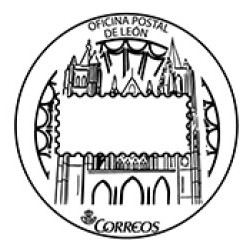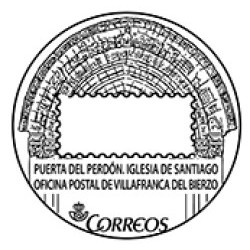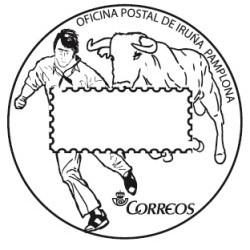2101) "El Camino de Santiago" (or The Way of St. James"), Spain: Correos Espana (Spanish Post) has issued a booklet and Philatelic Document of 15 stamps on the occasion of the Xacobeo 2021-22: Date of issue: 28.10.2021:
About "El Camino de Santiago":
The El Camino de Santiago Booklet with three illustrated panes brought out by Espana Correos (Spanish Post)
"El Camino de Santiago", (or "The Way of St. James"), is a network of pilgrims' ways or pilgrimages leading to the shrine of the apostle Saint James the Great in the cathedral of "Santiago de Compostela" in Galicia in northwestern Spain, where tradition holds that the remains of the apostle are buried.
Many devotees follow its routes as a form of spiritual path or retreat for their spiritual growth. It is also popular with hiking and cycling enthusiasts and organized tour groups.
Created and established after the discovery of the relics of James of Zebedee at the beginning of the 9th century, the Way of St. James became a major pilgrimage route of medieval Christianity from the 10th century onwards.
It was only after the capture of Granada in 1492, under the reign of Ferdinand II of Aragon and Isabella I of Castile, that Pope Alexander VI officially declared the Camino de Santiago to be one of the "three great pilgrimages of Christendom", along with Jerusalem and Rome.
The Camino de Santiago, which corresponds to several routes in Spain and France, was declared in 1987 as the "First Cultural Route of the Council of Europe".
Since 2013, the Camino de Santiago has attracted more than 200,000 pilgrims each year, with an annual growth rate of more than 10 percent.
Pilgrims come mainly on foot and often from nearby cities, requiring several days of walking to reach Santiago.
The French Way gathers two-thirds of the walkers, but other minor routes are experiencing a growth in popularity.
The French Way (Camino Francés) and the Routes of Northern Spain are listed in the World Heritage List by UNESCO in 1993.
Since the end of the 20th Century, the interpretation of the Catholic sanctuary has undergone a doctrinal evolution.
For example, the word "tomb" has disappeared from the speeches of popes since John Paul II. Additionally, when speaking of the memorial of St. James, John Paul II did not use the word "relics", and Benedict XVI said simply that the Santiago de Compostela Cathedral "is linked to the memory of St. James".
Adds the Book titled "TREASURES OF THE WORLD" a complete guide to UNESCO World Heritage Sites" in my personal library -
"Route of Santiago de Compostela":
" This route from the border between France and Spain was - and still is - taken by pilgrims to Santiago de Compostela in Galicia. Some 1,800 buildings along the route, both religious and secular, are of great historic interest.
Pilgrimages were an essential part of Western European spiritual and cultural life in the Middle Ages and the routes they took were equipped with facilities for the spiritual and physical well-being of pilgrims.
The Route of St. James of Compostela has preserved the most complete material record in its ecclesiastical and secular buildings, settlements and civil-engineering structures.
The route played a fundamental role in encouraging cultural exchanges between the Iberian peninsula and the rest of Europe during the Middle Ages.
It remains a testimony to the power of the Christian faith among people of all social classes and from all over Europe.
Two access routes into Spain from France enter at Roncesvalles (Valcarlos Pass) and Canfranc (Somport Pass) and merge west of Pamplona. The route passes through five autonomous communities and 166 towns and villages, and include over 1,800 historic buildings. In many cases the modern road runs parallel to the ancient route. Thousands of pilgrims follow it on foot or bicycle every year."
Stamps of the Camino de Santiago:
The history of stamps and the Camino de Santiago has always been very close.
From the first stamp dedicated to a Holy Year in 1937 to the present day, "the Way" has featured in a number of different stamps.
The Camino de Santiago itself has a specific stamp of B Tariff, issued in 2016. It depicts the main façade of the Cathedral of Santiago de Compostela, welcoming the pilgrims, and features the traditional scallop shell.
The Xacobeo 2021-2022 Stamp:
On the occasion of the Xacobeo 2021-2022, Espana Correos has made a very special issue: a commemorative stamp starring Floreano, one of the most beloved characters of the Galician press.
Created by the cartoonist Gogue, Floreano has made the leap from the pages of Faro de Vigo to become a pilgrim, with his cape, staff and pumpkin. The special postmark that accompanies this stamp is dedicated to the Xacobeo 21-22.
Philatelic Credential Correos:
The Camino de Santiago can have a very special companion on the road - the Philatelic Credential, a tribute to the card that all pilgrims must have stamped during their Camino de Santiago.
The Philatelic Credential features 15 stamps from Correos that include some of the most emblematic stages of the French Way, from Roncesvalles to Santiago, passing through Pamplona, Burgos, León, Astorga, Ponferrada or O Cebreiro.
This document is not a replacement for the credential issued by the Cathedral of Santiago or the Associations of Friends of the Way to earn the Compostela. Nevertheless, it is a very special memento of "the Way".
As with the official Credential, the Philatelic Credential can be stamped at "Associations of Friends of the Way", in local parishes and in Correos Offices along the "French Way".
The Correos Offices in the towns that feature on a stamp of the Philatelic Card also have tourist postmarks that depict the great architectural richness of these places. The first of these postmarks can be found at the office of Burguete (2.5 km from Roncesvalles). Several post marks are available at authorised centres/Correos Post Offices which are a special treat for Philatelic lovers.
On the occasion of Xacobeo 2021-2022, a commemorative postmark is also dedicated to the Holy Door of the Cathedral of Santiago in Correos' Main Office in Santiago (Rúa do Franco, 4).
Interesting links to posts on Portugal and Spanish Coins and postage stamps on this blog:
9) "Nacional Museo del Prado", Spain: Celebrating the Bicentenary milestone (1819-2019): Commemorative Silver Coins of 30 Euros issued by Fabrica Nacional de Moneda y Timbre - Casa Real de la Moneda on 20.11.2019: Coins minted by the Madrid Mint
12) The New Silk Road: A Joint issue of a two stamp set of 1.50 Euros each by Spain (Correos Post) and China: Stamps issue date: 01.07.2019
13) Charming Towns, Spain : For the past five years, Correos (Spanish Post) has issued Stamps and Postcards on four beautiful Spanish villages as old-fashioned accordion-style postcards: Date of PostCards/Stamp set issue: 30.03.2020
14) "International LGBTQ Pride Day", Spain: The LGBTQ Pride Day Flag (Rainbow Flag) depicted on the first ever stamp issued: Date of Stamp issued: 15.06.2020
15) "Card Games", Spain: Correos Espana (Spanish Post) has issued a Stamp Sheet of 3.80 Euros representing the four suits (Swords, Pentacles, Cups & Wands) in a Tarot Deck, as the Origins of Card Games: Date of Stamp Sheet issue: 02.07.2020
6) "The Joker", Portugal: Portugal Post has issued a set of four stamps featuring "The Joker"character of DC Comics, who is an archenemy of the "Batman": Date of Stamp issue: 31.03.2020
7) Portuguese Numismatics (1st Group): A set of four Stamps in the values of N20g, A20g, E20g and 120g issued by CTT Correios (Portuguese Post) in partnership with INCM ("Imprensa Nacional-Casa da Moeda (the "Portuguese Mint & Official Printing Office") depicting coins from various periods of history: Date od Stamp set issue: 22.04.2020
12) "Linha Do Douro" ("The Douro Line (Train)", Portugal:12th Coin in the Ibero-American Coin Series titled "Historic Trains" brought out by the "Imprensa Nacional-Casa da Moeda" (INCM): Date of issue: 06/2020
6) Leonardo da Vinci, France: The latest issue from the Monnaie de Paris, France highlights him on the latest Europa Silver Star Coin Programme issued by the Paris Mint: Coin issue date: 03/2019
7) i) "Europa Coin Programme" or the "European Star Programme" or the "Eurostar Programme" ii) Central Bank of Malta issues 50 Euro (Gold) and 10 Euro (Silver) Proof Coins featuring "Architecture and artwork of the Gothic Era" in 05/2020 (which is a part of the wider programme focussing on the Ages of Europe: Date of Coins issue: 08.05.2020


























Santosh Khanna has commented:
ReplyDelete"Thanks for sharing this informative post. Happy Diwali."
Thank you so much, Khanna sahab. Wish you a very Happy Diwali too.
DeleteVinod Khurana has commented:
ReplyDelete"Nice information."
Thank you, Vinodji.
DeleteRajan Trikha has commented:
ReplyDelete"Well-compiled post".
Thank you, Trikha sahab.
DeleteRsanker Sharma has commented:
ReplyDelete"Very nice and informative."
Thank you, Sharma sahab.
Delete